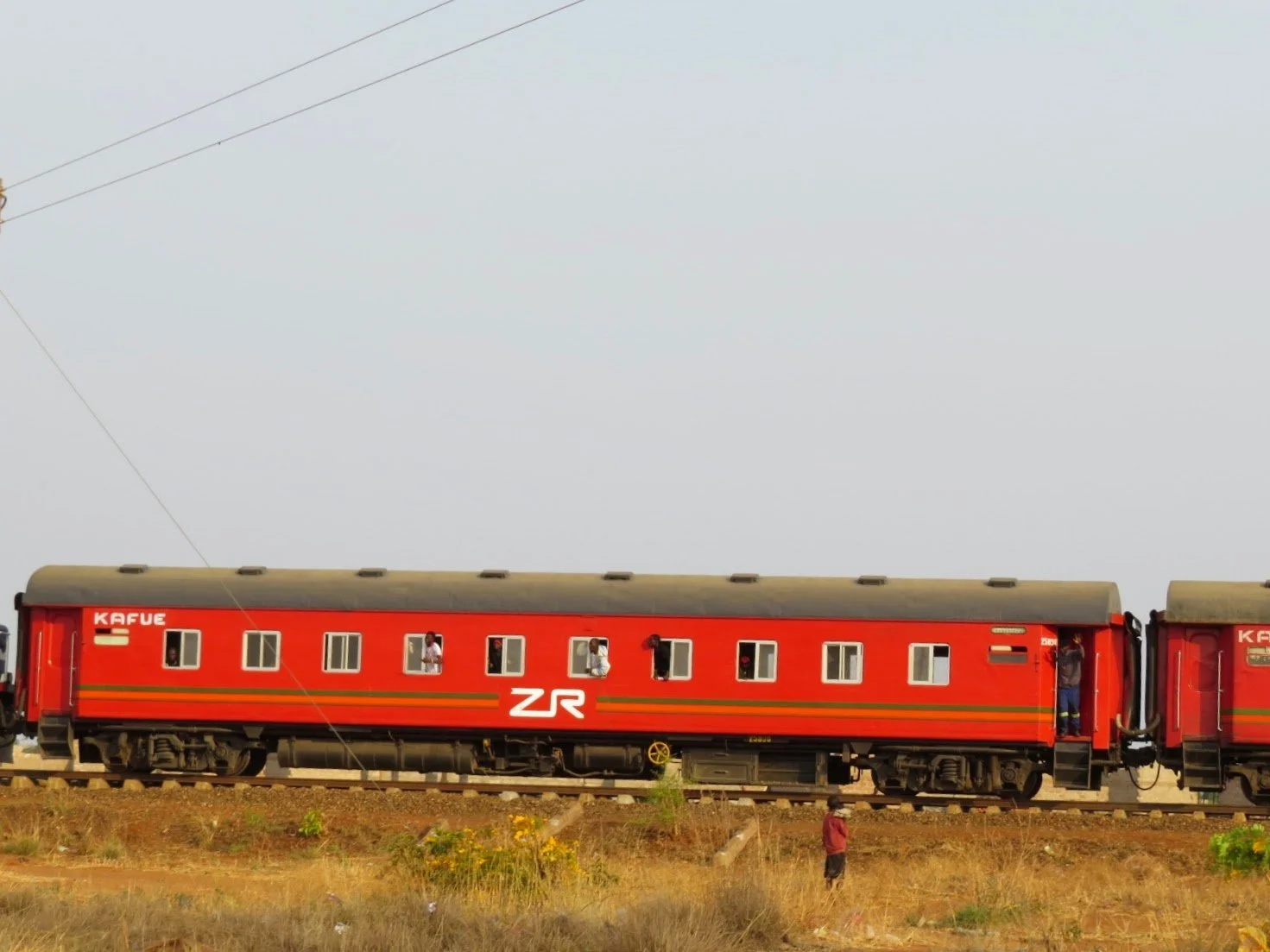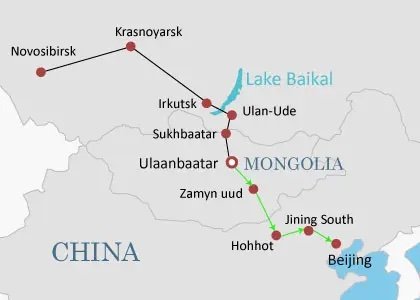Trains.
Planes will get you there faster. Cars are more personal. But trains? Trains have some mythical blend of the promise of adventure and a hint of nostalgia… What is it that makes train travel so different? You can get up and stretch your legs… You can eat and drink while zooming along. We have enjoyed train trips in many countries. And when I hear the ting-ting-ting of a railroad crossing, I want to hop on and see the view from a train window.
The longest train trip we took was probably the one across the Nullabor Desert of Australia. We boarded the Indian Pacific in Perth on Australia’s west coast. For 3 days and 2 nights we chugged along through the great empty Outback. It’s 4,352 KM from Perth to Sydney. We took that train to Adelaide. There might not be a better way to get an impression of vastness. Flat, dry grasslands and rocky dessert spread to the horizon. And yes, you can spot an occasional kangaroo hopping away.
Cook is a railway stop which is on the longest stretch of straight railway in the world - 478 kilometres (297 mi) - extending from Ooldea, South Australia to beyond Loongana, Western Australia. It might be unmanned now but when we stopped there, the population was 2 and they all showed up to meet the train.
The view from the train across the Nullabor was similar to that of the Gobi Desert where we took the train from the capital city Ulaanbaatar, to Beijing via Seinshand on the Trans Mongolian Railway. That, too, was about a 3 day and night journey but we broke it up by spending a week or more in the Gobi Desert where everything was sand. The train itself was a disillusion. Nothing luxurious but rather old, dusty and bare. There was no food car on the train and, not knowing this, we did not bring food. Kind Mongolians shared their salted tea (!) with us but we were pretty hungry by the time we reached Beijing. However, the most unusual thing happens with this train.
The train in Mongolia.
There is a difference in the width of the railroad tracks between Mongolia and China. That means trains cannot just cross the border and continue. Mongolia has a 1,520mm rail gauge – a legacy from the Soviet era, and is called the "Russian gauge" – and China has a narrower 1,435mm gauge, a more widely used track width across the globe that's known as the "Standard gauge."
This means that each train crossing the border is forced to make long stops to change the wheels! Mongolia's increasing number of mining companies consider this a logistics bottleneck, but most Mongolians see it as a matter of national sovereignty – a necessary protection for their sparsely populated homeland and its vast mineral resources from the ever-present “Chinese threat.”
We watched from the window, fascinated by this unusual procedure, as our entire set of train cars was hoisted into the air. Mongolians wheel assembly was taken away and replaced by Chinese wheels before we were lowered again ever so slowly, luggage, passengers and all. This took a few hours but was great entertainment before we chugged across the border to Beijing (where we feasted on Peking duck!). Another place I saw a narrow gauge railway track was in Jordan. The Hejaz track was a single track, narrow-gauge (1.05 m), railway extending 1,302km from Damascus to Medina. The railroad reduced a typical 40-day journey by camel caravan to just four days but was narrow gauge to prevent invasions from neighbouring countries.
Kees and I grew up in Europe were trains were a common mode of transport. By and large, European trains are abundant and efficient. If the schedule says they depart at 9:01 they will depart at 9:01 and not at 9:02. However, cancellations and rail closures do happen all the time. Using a website like Rome2Rio is a good plan if you are traveling (see link below).
Dutch trains have a “silence” car where no cell phones or discussions are allowed. During National Book Week trains even sport book images.
Time travel in Romenia.
Trains in Romenia took us back in time. The rusty wheels creaked along tracks lined by farms with haystacks and took us all the way to Bram’s Castle, aka Dracula’s Castle. The conductor with his red/green baton seemed to have stepped straight from the pages of a children’s book as he blew his whistle. In Holland we discovered that train conductors no longer blow on a whistle. Since Corona and mouth masks, the Dutch trains are told to get a move on by the same whistle sound but it is now produced by a push of a button.
How many kids dream of being a conductor on a train? This steam train in south Netherlands treats tourists to a nostalgic trip through the countryside.
One of the most famous and historic routes is the White Pass & Yukon Route railway from Skagway, Alaska to Bennett, Yukon across the White Pass. This gold rush trail is as romantic as it gets. When gold was discovered in Yukon, in 1896, the only route was on foot across the Chilkoot Pass. To accommodate the thousands of gold seekers trekking to the Klondike, an easier route had to be found along Lake Bennett. As early as 1898, construction began on yet another narrow gauge railway. You can still take this train which is now a major tourist attraction.
We much enjoyed taking the Cascades Amtrak train from Vancouver to Seattle, and even on to Eugene, Oregon. North American trains seem to be less reliable than European ones but it’s still fun to sit back and relax instead of driving the I-5.
Amtrak from Vancouver.
The Cascades’ dome car is great with kids. We enjoyed the scenery, played games and ate our own food while traveling the tracks from Seattle back to Vancouver.
Perhaps the worst train trip we ever took was blessedly short. The ancient train from Naples to Pompeii seems to date back to the time when Vesuvius erupted… We found our way to the Napoli Garibaldi station where the Circumvesuviana was supposed to arrive to take us to Pompeii (the excavation site), not Pompei (the name of the modern city)! We were directed to some down-and-out platform and stood waiting for a train that did not come. More tourists did come until, after an hour, the platform was so dangerously packed that people start to get pushed off the platform. No one came to regulate the crowd. More people tried to push onto the platform especially once a train finally approached. The train then got so packed that you literally could not have wedged a newspaper in between us and the people around us. It was hard to breathe. You could not turn around. And it was hard to even crane your neck to see what the next stop was. But even if you did spot a sign at a next station, you could not guess where you were because all signs were heavily painted in graffiti. Not a great way to welcome visitors. The slow train hugs the base of Mt. Vesuvius, hence the name. We eventually did arrive at Pompeii but swore never to take that train again.
The train that skirts the Ligurian Sea in Cinque Terre is much more fun than the train to Pompeii!
The train in Cinque Terre, Italy connects the villages of Monterosso, Vernazza, Corniglia, Manarola and Riomaggiore and is much more pleasant. You can get on and off anywhere. It’s not a little sightseeing train, as I had imagined before we went, but a regular train that services these towns and offers a breathtaking view in the process.
Casablanca, Morocco has a state of the art train station.
It was too bad that the train I took from Tangier, Morocco to Marrakech was a night train. I would have loved to catch glimpses of the Sahara. The 575 km (357 mi) stretch is through unique Moroccan landscapes. The bunkbeds in my ‘women only’ sleeping compartment was spartan but we were provided a sheet and a pillow. The train’s sounds and movement rocks us all to sleep instantly.
And then there is China’s high speed train… What a contrast to the historic trains we’ve been on! I took the Maglev Train, the first commercial maglev line in the world, from Shanghai to Pudong International Airport. You better hang on to your seat as the doors close. The train speeds up and throws you back in your seat like an astronaut. On a screen, I watched the train’s speed accelerate from 0 to a top speed of 431 km/h, in a matter of seconds. The 30 km (18.6 mi) journey takes a mere 8 minutes! Fast? Yes! Romantic and full of character with the promise of adventure like old, creaking, chugging trains elsewhere in the world? No…
BOOK: Train Beyond The Mountains, Rick Antonson.
RESOURCES:
Rome2Rio - I recommended downloading the app on your phone.
9292 - travel in the Netherlands, also an app.
TrainLine - for train travel throughout Europe.
White Pass & Yukon Route Historic Railway
Cinque Terre train travel


























